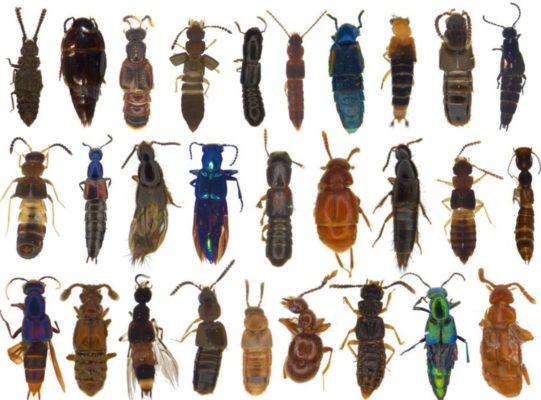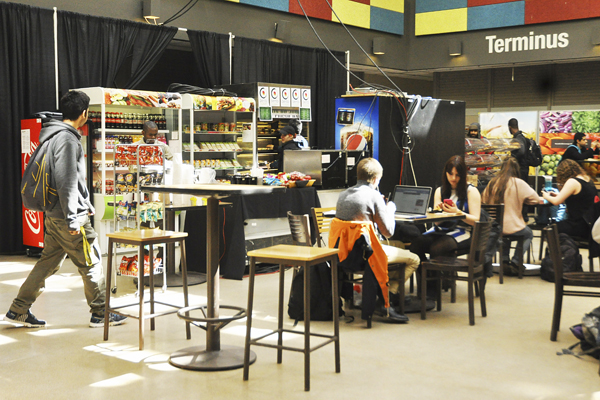ALL YOU NEED IS BEETLES
Sarah Dolson, a PhD candidate at the University of Ottawa, has always been interested in how animals and insects in particular are distributed across the globe. Before arriving at the U of O, she completed her master’s at the University of Guelph, where she studied the diversity of rove beetles across elevation gradients in northwestern Costa Rica with Dr. Alex Smith.
For her PhD, Dolson is sticking with insects and elevation. Where she’s asking the same type of questions but on a much larger scale. This would require her to look at elevation patterns occurring across the entire globe rather than regionally.
What are rove beetles?

According to Dolson, rove beetles are an incredibly diverse, weird and wonderful group of animals. What makes these beetles unique, is their really short elytra.
“If you think about a beetle, and how they’re really strong and armoured, rove beetles actually have that armour on the back but it’s short and [as a result] they have an exposed abdomen. So they’re kind of weird-looking, they sort of look like earwigs,” said the PhD candidate.
Rove beetles happen to be the largest group of animals that exist. However, they remain one the most understudied. This combined with the fact that they are exceptional model species for testing questions related to distribution made them perfect candidates for Dolson’s research.
Research methods
In order to conduct her research, Dolson needed to identify how many staphylinid species (rove beetles) were present within the Área de Conservaciόn Guanacaste (ACG) along a 1,500 metre elevational gradient, as well as how abiotic factors (precipitation and temperature) affect the richness and phylogenetic structure of rove beetle communities.
To understand how diversity is changing with abiotic factors, the U of O PhD candidate used a combination of weather markers that were collected while doing sampling.
“We also used publicly accessible data such as WorldClim. It’s a huge global database that has temperature and precipitation data and all sorts of other stuff. And so then we can just take that and then look at it with our diversity measurements.”
Dolson explained that to create a representative sample, they had to collect samples at different elevations.
“We set up all sorts of different traps, for example, pitfall traps, which are just sort of cans in the ground that insects will walk right into.”
“We had flying traps, called malaise traps, where insects will fly right into them, and then they may also crawl into some ethanol to collect. We also sifted the leaf litter. Most insects live in leaf litter, and so we just sift through it and all the bugs fall to the bottom.”
This data was collected twice a year between 2008 and 2017. This allowed Dolson to have access to an enormous collection of beetles across many years and seasons.
What is DNA barcoding?
Dolson struggled with identifying different rove beetles, since most have yet to be named and identified. In order to be able to differentiate between specimens, she used a technique known as DNA barcoding.
“DNA barcoding is where we take a little bit of their DNA and then we sequence it to see how its DNA compares to another specimen. So by doing that, we can say, you know, this is a different species from this,” explained Dolson.
“We had to use the DNA then as sort of your marker. It’s one of the only ways that we can sample these types of insect communities, especially tropical leaf litter insect communities. Because they range in size some of them are smaller than the bit of lead that you have at the end of your pencil,” added Dolson.
What were the findings?
The findings of the study surprised Dolson, since they went against a previous notion that tops of mountain ranges are desolate when in fact Dolson’s study shows they’re full of life.
“When you look at insect elevation studies, you see all sorts of different responses and there’s a few common ones. Sometimes we see that insect richness will decrease with elevation. Because as you’re going to the tops of these mountains, the conditions become less favourable for anything to exist,” she said.
But this wasn’t the case with Dolson’s study.
“The insect richness was highest right at the top of the mountains. [This] means that across this whole gradient, they’re super abundant and super diverse right at the tops of the mountains,” she explained.
It’s important to note that since there is greater diversity at the top this could indicate that rove beetles may be more susceptible to climate change. As temperatures warm there’s a predicted upslope movement to colder areas. However, as they move upwards there’s less and less geographic space.
Field experience in Costa Rica
Dolson’s research allowed her to travel to the Área de Conservaciόn Guanacaste in Costa Rica, which contains rainforest lowlands of various types, wetlands, and mountain ranges upwards of 1,500 metres.
She described her experience there while sampling the beetles as one she will never forget.
“[It was] really awesome, we worked on one of the volcanoes called volcano Cacao. And it goes from essentially right at sea level to 1,500 metres high.”
“It’s a really amazing place because at the tops of these volcanoes or mountains, you have these tropical montane cloud forests. [They’re] really wet and actually pretty cold, it probably doesn’t get lower than 15 degrees [celsius] but because it’s so wet, it feels freezing up there.
Then you go down to the beach, which is extremely hot and extremely dry. So you have just this amazing range where you can go from the bottom to the top in a day.”
Dolson is currently working on her PhD research with Dr. Heather Kharouba in the faculty of science. In the future, she hopes to answer questions related to how insect diversity is changing across global elevation gradients.






